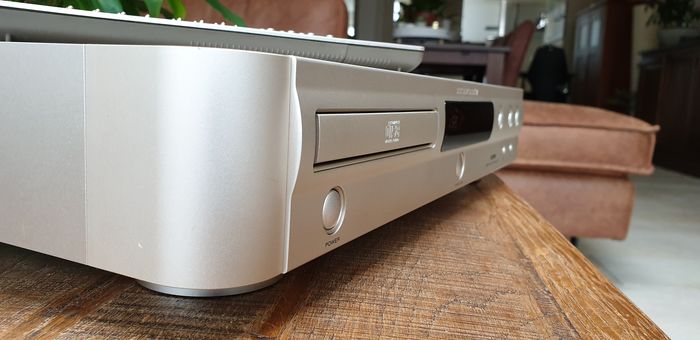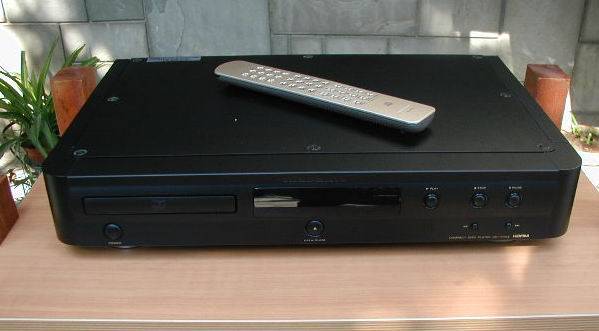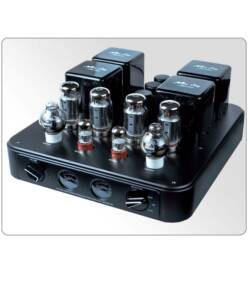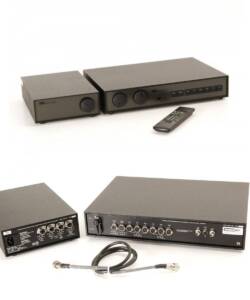Marantz CD17 mk2 HDAM (Black)
Original price was: R38,000.00.R5,500.00Current price is: R5,500.00.
Putting your hands onto it
Few buttons on the front panel allow you to play and stop the player, to put it in pause, to skip a track and to turn on/off it. In the rear panel you have standard RCA outputs, both analog and digital and a bus output for similar Marantz components (amplifiers etc.). The power cord isn’t (sadly) detachable.
The remote control is quite easy to use though it works only if pointed directly to the player, probably because the IR sensor is hidden deeply inside the display. Similarly to other Marantz players (even the old CD 63) the display can be *trimmed*, some audiophiles swear that the display light circuits can affect the quality of the reproduction…
Since the CD 17 is a CD player oriented to the audiophile crowd, it is quite strange that the level of the analog output is adjustable by means of a volume control (remote). Also, if you decide to use this feature to couple the CD player directly to your power amplifier, please consider that the CD 17 isn’t able to remember the previous volume settings…so, you’ve been warned!!!
The headphones output isn’t available, since many audiophiles consider this as a non-purist device that can affect the quality of the sound… The overall feeling, using the CD 17, isn’t particularly enjoyable and the especially the transport seems weak and *cheap* (light plastic, that is).
How does it sound?
The CDM 12.3 transport is considered a very good device but then I simply can’t understand why its performance can be CLEARLY improved using a simple CD stabilizer like the Moster Cable Discus+
Simply put, any CD player is affected by some problems due to the fact that the disc spins very fast, vibrating and resonating so that any device that can dampen these vibrations does have an audible effect on the sound.
Is it so difficult to design and build better (vibration-free) transports? Maybe these would be outrageously expensive but please think that some HiFi Companies have started designing better trasports (Teac VRDS, Pioneer Stable Platter etc.).
So I’ve decided to use the Moster Discus+ during the whole listening test, its effect on the sound of the CD 17 is so audible that it would be a crime to listen to the CD 17 without this stabilizer.
The CD 17 does sound good, so good that every time I try to focus my attention on some aspects of the reproduction, I end up listening to the whole CD and to the played Music instead.
It is very airy but not *light* or overbright. Indeed the mid-to-high range is smooth and sweet exactly like the low-mid range, clean and articulated. The bass range is slightly soft, though it remains controlled even with not-so-good recordings.
Indeed this is one of the big pluses of the CD 17: it allows you to listen even to mediocre recordings without fatiguing your ears. I don’t know which is the cause for this behaviour: probably the ability of the CD 17 to extract so many informations from the disc, especially allowing the creation of a virtual soundstage which is large and deep, where the instruments are perfectly focused, with much air among them, very natural to say it in a word.
Conclusions
The CD 17 costs here in Italy (as usual, your mileage may vary, HiFi is pretty expensive here) 1800 $ (black finish) and at this price it is one of the better sounding CD players I’ve heard. Also let me add that the CD 17 is very easy to match with different HiFi systems.
I’d be glad to test the Ken Ishiwata Signature (KIS) version of the CD 17: it costs a bit more (2200 $ more or less) but it could be money well spent.
Marantz 17-Series System
MARANTZ REVIEW Ken Kessler
Having established itself as THE brand for affordable audiophile CD players, Marantz is going out of its way to prevent what’s known as ‘cherry-picking’. Cherry-picking happens when a brand has one outrageously successful product, but the rest of the range is just so-so; retailers order the star item by the truckload, but rarely stock anything else from the range. In Marantz’s case the company would prefer to see its myriad SE-suffixed CD players connected to Marantz amplifiers, and the company has already issued plenty of decent amps worthy of the CD-63SE K.I., et al. But last year the company launched a Ken Ishiwata’d CD player further up the price ladder, and the competition hots up when you’re finding homes for £1100 source components.
MC reviewed the CD-17 K.I. Signature last May; it took until late ’97 before the PM-17 amplifier arrived. But it was worth the wait, especially as Marantz decided to make it part of a complete set-up, thus cross-pollinating with another genre. By releasing the ST-17 tuner as well, the K.I. Siggie owner can now create a system offering full remote control of the three components, as well as uniform aesthetics. (Before you ask about suitable speakers, note that Marantz distributes Tannoy in the UK, so they’d prefer it if you sourced your speakers from Scotland.)
You already know about the CD-17 K.I. Signature, its built-to-boogie solidity, sleek low profile and involving, up-front sound. Imagine a CD-63 Mk II SE K.I. exhibiting even greater refinement and better dynamics and you’ve got its measure. What the matching amp and tuner had to do was reflect this level of sound quality, while sharing the ultra-luxurious finish, feel and functionality. And, given the success of the CD-17, the need for stablemates was pressing: its unique look makes the CD-17 stick out like a Ferrari amongst Fords when sharing shelf-space with most other amps.
Although the 17-Series is offered in black, as was the sample photographed for MC’s article, the system really does blossom in a coating of traditional Marantz champagne/gold. It creates a delicious visual contradiction, the gold colouring making the equipment look light and delicate, when the tuner weighs an impressive 5.1kg and the amplifier a meaty 15kg. These are not filled-with-air boxes but substantial constructs which will impress the hell out of you when you unpack them. It’s what you’d expect if Porsche ever made hi-fi equipment.
Although you can stack them, you won’t be able to put the amp on top as habit would dictate, because it’s deeper (and a bit taller) than the CD-17 and the ST-17. They share footprint dimensions of 454x300mm, while the CD player is 81mm tall and the tuner a mere 68mm. The amplifier requires a slot measuring 454x110x444mm (WHD). But I managed to stack ’em with the amp below, and I worried not at all about too much heat, thanks to the system’s first talking point: a front-panel mounted temperature gauge.
Try though I may, I can’t name another component – not even an all- valve or pure Class-A solid-state amp – which comes fitted with a thermometer. The PM-17’s ‘Warm-Up Meter’, though, tells you more than whether or not the amp needs more ventilation; as its moniker suggests, the gauge tells you when the amplifier has reached the operating temperature for best performance. After roughly 30min depending on ambient conditions, the needle should reach the 2/3rd point on its arc. I ran it for days at the bottom of a stack, admittedly on an open surface, and the needle never moved past the optimum point.
It’s tweaky touches like this, along with the extra-large feet, the overkill socketry, the heavy-duty binding posts and a source-direct setting bypassing the tone and balance controls which allow the ’17 to remain firmly a part of the audiophile camp, despite remote control status and interior-decorator-friendly looks and dimensions which place it in the ‘Next Level Above Midi’ arena. The aforementioned cross-pollination between genres is simply the blending of audiophilic performance with convenience, tempering the minimalism of short signal paths and by-passable circuitry with the niceties that midi-system owners take for granted. Buy if the cynic in you thinks that there’s a sonic price to pay for these luxuries, check out what’s on offer besides a hand-held IR commander.
From left to right, the PM-17’s front panel offers a source selector marked ‘Phono’, ‘CD’ and line inputs 1-3. The differences are reinforced on the back panel, which features a button to choose between mm and m-c for the phono stage and an earthing post, while CD is singled out from the other line sources with more substantial phono sockets, although all of the connectors are gold-plated. Below the source selector is a headphone output, then a row of controls for record selection, the choice of two tape decks, a speaker on/off button and the IR receptor. The thermometer is positioned dead-centre, above the on/off switch. To the right are balance, bass and treble, the rotary volume control, and the source direct selector for by-pass mode.
Although rated at 60W/ch, the PM-17 acts like an amp boasting three times that power. Driving either the Apogee LCRs or ATC’s A7s, it never required a setting past the 11 o’clock position for near-headbanging purposes firing lengthways down a 22x14ft lounge. And however precious its low profile and remote control makes it seem to purists, the PM-17 was designed for a hard life. Among its design details are an overspecified power supply with a ‘Super Ring-Core Power Transformer’ (which I think is Marantz-ese for a toroidal), dual-mono construction, a 4-gang active volume control, silver-relay input selection and the aforementioned hefty chassis to create a vibration-free environment. External confirmation of the purist intent also includes enormous WBT speaker terminals and pre-amp out socketry for driving a second amplifier.
For serving as the heart of either a purist’s system or a facility fanatic’s operations centre, the PM-17 seems to have everything covered. It just seems so right, whatever hat you’re wearing at the time. The sheer convenience of its comprehensive remote control, with buttons which change function according to which source is selected, the fuss-free behaviour, the comprehensive source routing options – it’s one of the most ‘fun’ Marantz integrateds since the legendary PM-4. What makes it a prime candidate for those who hate to mix brands, though, is the existence of a matching tuner.
RDS is something which comes in handy in the car – I wouldn’t be without it on the accursed M25 – but not something I’d ever felt to be necessary for home use. Then again, I live in what is probably the biggest transmission hell-hole in England: East Kent. Still, I managed to trigger all of the RDS functions, and got a minor, if transient kick out of seeing legends scroll by, e.g. “Status Quo Rockin’ All Over The World”. Given that I still use tuners so devoid of frills like presets, let alone the facility to program names for each preset, I must point out that I was more impressed by the ST-17’s beautifully weighted ‘gyro’ tuning wheel, reminiscent of older Marantz tuners. Amusingly, it also selects presets, but you have to develop a feel for it; it’s actually easier to access the presets from a numeric keypad, as on the remote control.
For such a cleanly-styled device, the ST-17 actually boasts a fair number of controls. In addition to the comprehensive digital display and the gyro wheel, the ST-17 also provides selection between two aerials and wide or narrow bandwidths, both functions monitored by LEDs, a display mode button, a mono button and the myriad keys needed to address RDS functions like station labelling. LS, SW and FM bands are offered, along with 60 presets, and the ST-17 is one of the most substantially-built tuners this side of a Sequerra or a Trio L-01T – both of which were used for comparison.
And, surprise, surprise, the Marantz wasn’t slaughtered by these lofty rivals. How much of it’s down to what RDS does to the signal and how much of it is simply the newness of the ST-17 versus the vintage Sequerra and Trio I can’t say, but the new differed from the old by exhibiting a character which I can only describe as ‘digital’. No, the difference isn’t entirely analogous with that noted between CD and LP, but it’s not that far-fetched a concept. The ST-17 sounded cooler, more detailed and more forward. On live broadcasts, it came close to the Trio for scale, but the Sequerra produced a wider stage. Given that all shared the same aerial and the signals strengths were at maximum, the ST-17 revealed a slight edge over its OAP rivals through far quieter backgrounds.
Both the Trio and the Sequerra delivered softer, sweeter highs, but the Marantz demonstrated faster attack. Bass was drier, too, the Trio and the Sequerra less suited to the sort of row created by electronic music. On spoken word, the Marantz avoided chestiness, but exhibited slightly hissier sibilants. Choosing between ’em? Let’s just say that the qualitative differences are so fine that I wouldn’t put it past regional transmission differences to turn it all around. Suffice to say, the sessions proved that the ST-17 is a stunning tuner…especially at £599.
Yup — £599 for a tuner not embarrassed by an old but revered Sequerra, or one of Trio’s (now Kenwood) sleepers. In fact, it sounded a lot like a radio version of the CD-17, which boded well for the system as a whole. Provided the PM-17 complemented the two.
Which it did in spades. As with the Audio Research SP8/VT60 package reviewed elsewhere in this issue, the combination yielded a silky, satisfying ‘whole’ – further confirmation, if any were needed, that one-make systems can provide undeniable coherence often missing from mixed-brand assemblies. Or achievable with the latter only through careful selection and painstaking set-up. Which is something precluded from Series 17 ownership: set-up was as simple as it gets.
Feeding non-Marantz sources, including the Theta Data III/Pro Gen Va digital front -end, the aforementioned tuners and a Thorens Jubilee/Audio Technica AT-F3 to sample the phono stage, the PM-17 emerged as the star of the system. However wonderful the CD-17 K.I., it’s still an £1100 CD spinner and therefore one of a number of superb contenders. The ST-17? Tuners are dependent on radio, which sucks in the UK, so it’s about as viable and liberating a source as 8-track, however good it sounds. But they do complete a system based on the PM-17, which – if you follow that reasoning – has the toughest job to perform. But, wow, does it perform.
Its driving capabilities are not an issue, the Apogee LCRs, old Quad ESL, Rogers LS3/5As and ATC A7s – as varied a mix as you could assemble – all working well with its 60W. It always erred on the sides of neutrality and transparency, and so admirably that I was able to A/B/C the three tuners in its three line-inputs with immediately discernible results. But that’s not to say it lacked character.
At times, the Marantz could sound – especially driven by the CD-17 – like a slightly less commanding version of the Krell KAV300i integrated: a bit less slam, a trace less bass extension, but almost as satisfying for overall competence. More direct competition, Roksan’s delightful Caspian for example, sounded more tube-like if less precise. What the PM-17 possesses, what makes it so like the Krell, is its resemblance to pure Class-A designs costing a load more money.
It never screams or shouts, yet it’s never reticent. The freedom from constraint, demonstrated by the way it handles all types of speakers with ease, unchallenged by their impedances, makes you think that you spent a lot more than £899. The value-for-money element is reinforced by the build quality, the styling and the surfeit of facilities. And while it’s never wise for a hi-fi product at this point to attempt to be all things to all men/women, the PM-17 comes microscopically close.
I can already feel the saliva welling up in the corners of my mouth in anticipation of a K.I. Signature version…
Review Marantz CD17
In the mid of the 70s I decided to buy a Marantz amplifier, attracted by the reputation that the American firm had among audiophiles. I was so excited to put my hands over a Marantz component that, after having connected it to my system, I didn’t believe to my ears: it was the worst sounding HiFi component I had ever listened to! It was the Model 1070, not exactly the cheapest amplifier of the Marantz HiFi range ot those years.
This amplifier, matched with a pair of Visonik David 6000, was simply unable to drive these tiny speakers and its clipping was evident for everyone. Switching to a honest Pioneer 8800 was a relieve to my ears…
Thinking at this sad event now, 25 years later, I suspect that it was MY own 1070 to sound that bad but then I decided that EVERY Marantz HiFi component sounded bad (well, I had also a Marantz tuner which wasn’t exactly a wonder).
Since then a lot of things have changed: now Marantz is owned by Philips and thanks to some clever ideas the old American firm has started to make some pretty HiFi components again. Some of these have soon become a reference (think, for example, at the budget CD players).
Some gear used for this test
Spendor SP2/2 loudspeakers
Sonus Faber Concertino loudspeakers
Suono Riferimento loudspeakers
Audioanalyse PA 60 amplifier
Orelle 100 amplifier
Orelle CD 100 player
Yamaha CDX 1030 player
Monster Cable Interlink CD, Interlink 300 e Esoteric Audio CD interconnects
Esoteric Audio Premier, Supra 2.5 power cables
Monster Cable Discus+ CD stabilizer, ART graphite pads, Tip Toes and other similar stuff 🙂
How does it look like
The Marantz CD 17 is available either in a classical black finish or in a gold luxury vest (the one in the picture above), in both versions this player is very good looking.
The overall construction appears as quite sturdy (ok, let aside the transport…) and, thanks God, the top cover isn’t the ubiquitous (and resonant!!!) U or C-shaped thin metal sheet. This should protect the CD 17 from nasty external vibrations coming out from the loudspeakers. The transport here is the classical CDM-12.3 while the D/A conversion uses bitstream DAC7 circuits.
Putting your hands onto it
Few buttons on the front panel allow you to play and stop the player, to put it in pause, to skip a track and to turn on/off it. In the rear panel you have standard RCA outputs, both analog and digital and a bus output for similar Marantz components (amplifiers etc.). The power cord isn’t (sadly) detachable.
The remote control is quite easy to use though it works only if pointed directly to the player, probably because the IR sensor is hidden deeply inside the display. Similarly to other Marantz players (even the old CD 63) the display can be *trimmed*, some audiophiles swear that the display light circuits can affect the quality of the reproduction…
Since the CD 17 is a CD player oriented to the audiophile crowd, it is quite strange that the level of the analog output is adjustable by means of a volume control (remote). Also, if you decide to use this feature to couple the CD player directly to your power amplifier, please consider that the CD 17 isn’t able to remember the previous volume settings…so, you’ve been warned!!!
The headphones output isn’t available, since many audiophiles consider this as a non-purist device that can affect the quality of the sound… The overall feeling, using the CD 17, isn’t particularly enjoyable and the especially the transport seems weak and *cheap* (light plastic, that is).
How does it sound?
The CDM 12.3 transport is considered a very good device but then I simply can’t understand why its performance can be CLEARLY improved using a simple CD stabilizer like the Moster Cable Discus+
Simply put, any CD player is affected by some problems due to the fact that the disc spins very fast, vibrating and resonating so that any device that can dampen these vibrations does have an audible effect on the sound.
Is it so difficult to design and build better (vibration-free) transports? Maybe these would be outrageously expensive but please think that some HiFi Companies have started designing better trasports (Teac VRDS, Pioneer Stable Platter etc.).
So I’ve decided to use the Moster Discus+ during the whole listening test, its effect on the sound of the CD 17 is so audible that it would be a crime to listen to the CD 17 without this stabilizer.
The CD 17 does sound good, so good that every time I try to focus my attention on some aspects of the reproduction, I end up listening to the whole CD and to the played Music instead.
It is very airy but not *light* or overbright. Indeed the mid-to-high range is smooth and sweet exactly like the low-mid range, clean and articulated. The bass range is slightly soft, though it remains controlled even with not-so-good recordings.
Indeed this is one of the big pluses of the CD 17: it allows you to listen even to mediocre recordings without fatiguing your ears. I don’t know which is the cause for this behaviour: probably the ability of the CD 17 to extract so many informations from the disc, especially allowing the creation of a virtual soundstage which is large and deep, where the instruments are perfectly focused, with much air among them, very natural to say it in a word.
Conclusions
The CD 17 costs here in Italy (as usual, your mileage may vary, HiFi is pretty expensive here) 1800 $ (black finish) and at this price it is one of the better sounding CD players I’ve heard. Also let me add that the CD 17 is very easy to match with different HiFi systems.
I’d be glad to test the Ken Ishiwata Signature (KIS) version of the CD 17: it costs a bit more (2200 $ more or less) but it could be money well spent.
Description
Disc format: CD
Digital converter: PCM1716E
CD Mechanism: VAM1201
Frequency response: 5Hz to 20kHz
Dynamic range: 98dB
Signal to Noise Ratio: 103dB
Channel separation: 100dB
Total harmonic distortion: 0.002%
Line output: 2.2V
Digital outputs: coaxial, optical
Dimensions: 458 x 83 x 315mm
Weight: 8kg
Accessories: RC-DA17CD remote control
Year: 2003










